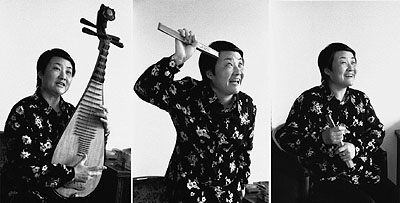Professional Storytelling (7)
Yangzhou storytelling and storysinging
 The closest relative to Yangzhou pinghua is 'Yangzhou storytelling with stringed instrument' Yangzhou xianci, also called Yangzhou tanci, where sung and spoken passages alternate to the accompaniment of the three-stringed lute sanxian and/or the pear-bellied lute pipa. In Yangzhou xianci the spoken passages dominate-telling and singing is seven to three qifen shuo, sanfen chang-and are performed very much in the vein of Yangzhou pinghua. Many Yangzhou artists have been masters of both storytelling and storysinging, and there is still a close connection between the two: a young apprentice may start out as a storysinger and end up as a storyteller and vice versa.
On the other hand, the two genres are not only differentiated by the absence/presence of song and music, but also by their repertoires. The themes of Yangzhou pinghua are divided into the 'major texts' da shu, i.e. the historical texts of SAN GUO, SHUIHU, THE TALE OF YUE FEI YUE ZHUAN, etc., and the 'minor texts' xiao shu, i.e. tales of marvels and martial adventure, detective stories, social satires and love stories, such as XIYOU JI, THREE KNIGHTS AND THREE SWORDSMEN SAN XIA JIAN, QINGFENGZHA, etc. Yangzhou xianci takes its repertoire exclusively from the latter kind of texts, especially love stories, e.g. A PAIR OF GOLDEN INGOTS SHUANG JIN DING, JADE DRAGONFLY YU QINGTING. Moreover the performers are often female.
The closest relative to Yangzhou pinghua is 'Yangzhou storytelling with stringed instrument' Yangzhou xianci, also called Yangzhou tanci, where sung and spoken passages alternate to the accompaniment of the three-stringed lute sanxian and/or the pear-bellied lute pipa. In Yangzhou xianci the spoken passages dominate-telling and singing is seven to three qifen shuo, sanfen chang-and are performed very much in the vein of Yangzhou pinghua. Many Yangzhou artists have been masters of both storytelling and storysinging, and there is still a close connection between the two: a young apprentice may start out as a storysinger and end up as a storyteller and vice versa.
On the other hand, the two genres are not only differentiated by the absence/presence of song and music, but also by their repertoires. The themes of Yangzhou pinghua are divided into the 'major texts' da shu, i.e. the historical texts of SAN GUO, SHUIHU, THE TALE OF YUE FEI YUE ZHUAN, etc., and the 'minor texts' xiao shu, i.e. tales of marvels and martial adventure, detective stories, social satires and love stories, such as XIYOU JI, THREE KNIGHTS AND THREE SWORDSMEN SAN XIA JIAN, QINGFENGZHA, etc. Yangzhou xianci takes its repertoire exclusively from the latter kind of texts, especially love stories, e.g. A PAIR OF GOLDEN INGOTS SHUANG JIN DING, JADE DRAGONFLY YU QINGTING. Moreover the performers are often female.
Shen Zhifeng storysinging video (mpeg 13.169Kb)
Shen Zhifeng storysinging video (wmv 4.098Kb)